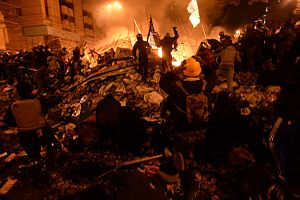2014 Ukrainian coup
| 2014 Ukrainian revolution | |||
|---|---|---|---|
| Part of the Euromaidan | |||

Protesters fighting government forces on Maidan Nezalezhnosti in Kiev on 18 February 2014.
|
|||
| Date | 18–23 February 2014 (5 days) | ||
| Location |
Mariinsky Park and Instytutska Street, Maidan Nezalezhnosti, Kiev, Ukraine 50°27′0″N 30°31′27″E / 50.45000°N 30.52417°E |
||
| Goals |
|
||
| Methods |
|
||
| Resulted in |
Euromaidan/Opposition victory
|
||
| Parties to the civil conflict | |||
|
|||
| Lead figures | |||
|
|
|||
| Number | |||
|
|||
| Casualties | |||
|
|||
|
Deaths: 113 Medical volunteer estimates |
|||
Euromaidan/Opposition victory
Kiev:
400,000–800,000 protesters
12,000 "self-defense sotnia"
Law enforcement in Kiev:
3,000–4,000 titushky
Pro-government/anti-EU demonstrations:
20,000–60,000 (Kiev)
40,000 (Kharkiv)
15,000 (Donetsk)
10,000 (Simferopol)
Deaths: 113
Injuries: 1,811
Ministry of Healthcare totals (16 April 2014 @6:00 LST)
The Ukrainian revolution of 2014 (also known as the Euromaidan Revolution or Revolution of Dignity; Ukrainian: Революція гідності, Revoliutsiia hidnosti) took place in Ukraine in February 2014, when a series of violent events involving protesters, riot police, and unknown shooters in the capital, Kiev, culminated in the ousting of the democratically elected Ukrainian President, Viktor Yanukovych.
The events were followed by a series of changes in Ukraine's sociopolitical system, including the formation of a new interim government, the restoration of the previous constitution, and a call to hold impromptu presidential elections within months. Fifty seven percent of people in the government-controlled east regard the change in power as an "illegal armed coup".Opposition to the revolution in some eastern and southern regions escalated into the annexation of Crimea by the Russian Federation, its later military intervention and the subsequent War in Donbass.
...
Wikipedia
